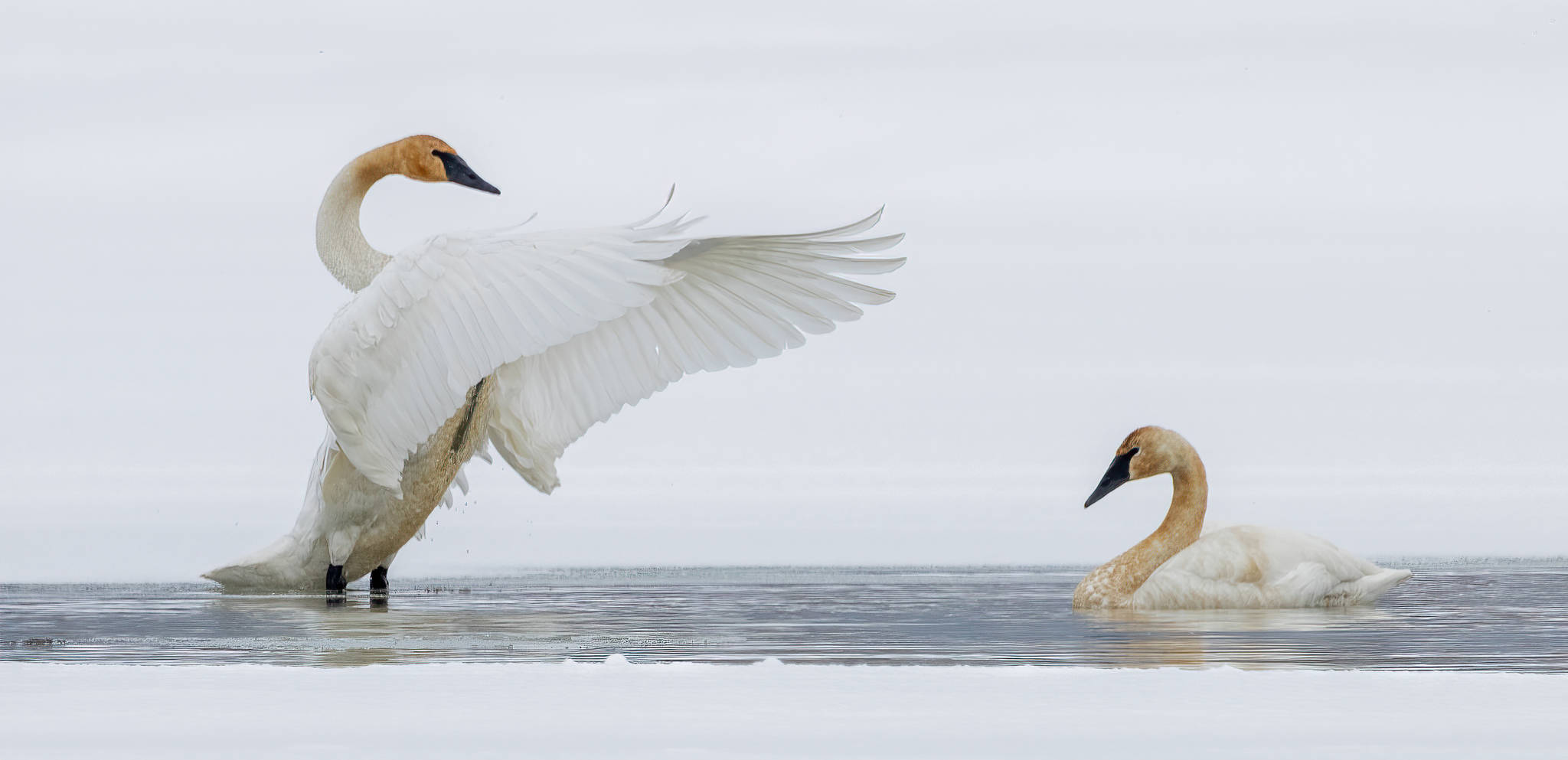By Mary F. Willson
For the Juneau Empire
Just before the vernal equinox, I strolled in the Eagle Beach area with a couple of friends. The lower reaches of the river bore a few cakes of ice drifting to the sea.
We stood on the bank, looking toward the Chilkats, enjoying the view.Then, down around a bend, one of those ice cakes surprised us as it suddenly sprouted a long neck and a head.
Oh. Not an ice cake.
Presently, the swan spread its big wings and set sail over the estuary. It was too far away to be sure of the species, but it was probably a trumpeter swan, which appear to be more common here than the smaller tundra swan.
Trumpeters migrate through here in spring and fall, and occasionally overwinter in estuaries and ice-free freshwater ponds. We see them in various places, including Amalga and the Dredge Lakes area. They are probably from the population that nests in coastal areas farther north; those that nest in the Interior are more likely to migrate inland. They have a huge wingspan, similar to that of eagles, but they are much heavier; they are said to be the heaviest flying bird in the world.
[On The Trails: Really, truly taking in the scenery]
Trumpeter swans once nested in marshes and ponds across much of North America, but hunting (for meat, feathers, skin), habitat destruction and lead-poisoning (from ingesting shotgun pellets that sank to the pond bottoms, where swans often feed) badly hurt their numbers. Thanks to conservation efforts, the species is not endangered now, and many breeding populations are thriving.
They can live to be more than 20 years old, but they mature slowly; they usually mature when 4-7 years old, occasionally sooner. They are monogamous, the pair bond usually lasting as long as both birds are alive and well, and the pair often staying together year-round.
On the nesting grounds, they choose freshwater marshes, ponds, and small rivers, building nests on beaver dams and lodges, hummocks, and platforms of floating vegetation. The nests are typically surrounded by water, giving them room for a running take-off when departing. Both male and female work on nest-building, both birds collecting material but the female doing most of the construction. The big eggs are laid at intervals of one and a half to two days (not daily, as in most birds). Both members of the pair incubate the clutch of (usually) four to six eggs, but neither develops an incubation patch on the body…they incubate the eggs with their huge, well-vascularized feet!
They are territorial, fiercely defending their chosen area at least until the eggs hatch and often, with declining intensity, until the chick fledge. That takes three or four months. Both adults tend the chicks, but become flightless for a few weeks during the summer molt. The young birds stay with their parents throughout their first winter. They forage on submerged and emergent aquatic vegetation, sometimes grubbing up tubers. Birds that winter farther south often forage in agricultural fields, and even digging up potatoes and carrots.
A bit later that day, we wandered out onto the sand flats exposed at low tide. And there was the swan again, walking slowly toward a group of grazing Canada geese. We imagined that it had thoughts of joining the group; swans sometimes migrate and forage in flocks of geese, ducks, and cranes. But these geese would not have it! They went on full alert and eventually took off. The swan then ran across the flats and took off toward the estuary.
Along the bank of the lower river, we found a lugworm, lying on the sediments. I don’t know why it was there — they normally they live in J-shaped or U-shaped tubes within the sediment, although they can move out and build a new tube at times.
At one end of the tube, they deposit coiled fecal castings on the surface, which we often see when the tides have not washed them away. Fecal deposition may sometimes be a slightly dangerous activity, because a foraging bird or crab may snap up the tail end; however, the worm can regenerate a new one. At the other end of the body is an eversible pharynx with a mouth that engulfs the sediment. The worm then digests some of the tiny organisms and perhaps organic detritus, passing out the partially cleaned-up sediment grains in the castings. Some lugworms can also feed on suspended particles. These worms breathe water, using their external gills alongside the body, when inundated by the tide, but reportedly can breathe air through the skin, when the tube is exposed at low tide.
The sexes are separate, raising the question of how these burrow-dwellers manage to make offspring. The available online reports are contradictory and confusing. The males simply eject sperm out into the water, hoping they can find eggs to fertilize. By some reports, the eggs are held in a female’s burrow and released sperm have to find and enter the burrow; that’s a system that probably works best when the worms live at high densities and spawn at about the same time, as indeed they often do. Then what? The fertilized eggs and larvae may be brooded in a female’s burrow; when still small, they leave and make a burrow of their own. However, we often see gelatinous sacs lying on the surface at low tide; they are tethered somehow to a female’s burrow. The sacs contain eggs or embryos; but why are they lying on the sediments?
• Mary F. Willson is a retired professor of ecology. “On The Trails” appears every Wednesday in the Juneau Empire. Kerry Howard and Aaron Baldwin provided photos for this weeks column. Baldwin also provided consultation.

